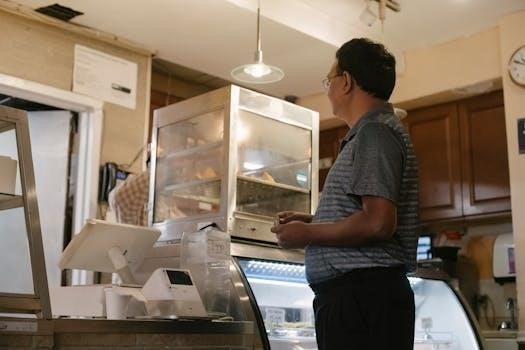
-
By:
- elizabeth
- No comment
bakery shop business plan pdf
Bakery Business Plan PDF⁚ A Comprehensive Guide
Starting a bakery is fulfilling and lucrative, but requires careful planning. A well-crafted business plan is your recipe for success. This comprehensive guide helps design a strategic plan, addressing financial management and brand establishment thoroughly.
A bakery business plan is critical for success, serving as the foundation for operations and setting goals to guide decisions. It’s essential to have a well-thought-out plan in place to maximize your chances of success. This guide walks you through creating a bakery business plan, complete with a template to help you.
Beyond providing information to investors, building a sample menu ensures your plan is airtight. A bakery business plan outlines objectives, target audience, and financial plans. It helps analyze the market, understand resource needs, and impress investors with your business’s potential for success.
Downloadable templates save time, offering a framework to create a professional plan quickly. Whether starting or growing, a business plan helps turn your baking dreams into reality by providing structure and insights for a thriving business.

Key Elements of a Bakery Business Plan
A bakery business plan includes an executive summary, company description, market analysis, products/services, marketing strategy, operations, management team, and financial projections. These elements are crucial for a comprehensive plan.
Executive Summary
The executive summary provides a high-level overview of your bakery business plan. It’s a concise snapshot, highlighting key aspects to capture the reader’s attention. It summarizes your bakery’s concept, mission, and objectives, and provides a brief overview of your products and services.
It should also outline your target market, marketing and sales strategies, and operational plan. The executive summary is also a good place to mention your management team and their expertise.
Crucially, it includes financial projections, demonstrating the bakery’s potential profitability and return on investment. It’s essentially a persuasive pitch, convincing readers of your bakery’s viability and potential for success. Keep it brief, impactful, and engaging to secure further interest in your plan. Investors and lenders will use this section to quickly assess whether your bakery is worth further consideration. A strong executive summary is key to obtaining funding and support.
Company Description
The company description section details the essence of your bakery. Begin by stating your bakery’s legal structure, ownership details, and location. Describe your bakery’s mission, vision, and core values. What makes your bakery unique? Is it your focus on organic ingredients, artisanal techniques, or a specific cultural niche?
Elaborate on the history of your bakery, if applicable. If it’s a new venture, explain the inspiration behind it and the gap in the market you aim to fill. Specify the types of baked goods you’ll offer – bread, pastries, cakes, or a combination. Highlight any signature items or specialties that set you apart.
Outline your commitment to quality, customer service, and community involvement. This section should convey your passion and dedication to creating a successful and reputable bakery. Investors need to see the bakery’s values and what makes it special.
Market Analysis
The market analysis section of your bakery business plan is crucial for demonstrating your understanding of the industry and your target customers. Begin by researching the local market, identifying your target audience. Are you catering to families, students, business professionals, or a mix? Determine the demographics, preferences, and buying habits of your ideal customers.
Analyze the competition in your area. Identify existing bakeries, cafes, and grocery stores that offer similar products. Evaluate their strengths and weaknesses, pricing strategies, and customer base. Look for opportunities to differentiate your bakery and carve out a unique niche.
Assess the overall market size and growth potential for bakeries in your region. Consider factors such as population growth, income levels, and consumer trends. Identify any emerging trends in the bakery industry, such as gluten-free options, vegan pastries, or artisanal bread.
Products and Services
In this section, clearly define the baked goods and services your bakery will offer. Will you specialize in artisan breads, custom cakes, pastries, or a combination? Create a sample menu showcasing your signature items and highlighting unique offerings. Consider including descriptions, ingredients, and pricing for each item.
Beyond baked goods, outline any additional services you plan to provide. Will you offer catering for events, custom cake design, or online ordering? If you plan to sell coffee, tea, or other beverages, include those in your product list. Detail any seasonal or special-order items you intend to offer.
Emphasize the quality and uniqueness of your products. Source high-quality ingredients, use traditional baking techniques, and highlight any special dietary options you provide. Showcase your bakery’s commitment to freshness, flavor, and customer satisfaction.
Marketing and Sales Strategy
Outline how you’ll attract customers and generate sales for your bakery. Identify your target market and detail the strategies you’ll use to reach them. Will you focus on local residents, tourists, or businesses? Develop a marketing plan that encompasses both online and offline tactics.
Consider utilizing social media platforms to showcase your baked goods and engage with potential customers. Create a website with online ordering capabilities. Explore partnerships with local businesses and participate in community events to increase visibility.
Outline your pricing strategy and how it aligns with your target market and cost of goods sold. Detail any promotional offers or loyalty programs you plan to implement. Focus on delivering exceptional customer service to build repeat business and positive word-of-mouth referrals. A marketing kit template will help you!
Operations Plan
Detail the day-to-day operations of your bakery. This includes the production process, from sourcing ingredients to baking and packaging. Describe your bakery’s location, layout, and equipment. Outline your staffing needs, including roles, responsibilities, and training plans.

Address inventory management, ensuring you have adequate supplies without excessive waste. Explain your quality control measures to maintain consistent product standards. Describe your opening hours and customer service procedures.
Detail supplier relationships, covering agreements and delivery schedules. Cover equipment maintenance plans, and outline procedures for handling customer orders, both in-store and online. Include measures for hygiene and sanitation. Make sure you create a plan for staffing and training.
Address any relevant regulations and licensing requirements. A well-defined operations plan ensures efficiency and consistency.
Management Team
Highlight the experience and expertise of your management team. Include brief biographies of key personnel, emphasizing relevant skills and accomplishments. Outline each member’s role and responsibilities within the bakery.
If you have an advisory board, introduce its members and their contributions. Demonstrate how the team’s collective knowledge will drive the bakery’s success. If there are gaps in your team, explain how you plan to address them, such as hiring consultants or additional staff.
If the bakery is owned equally by partners, specify their roles and responsibilities. If you have a sole proprietorship, highlight your experience and skills. Include information about any relevant training or certifications held by team members.
A strong management team inspires confidence in investors and stakeholders, so emphasize their qualifications.
Financial Projections
Provide detailed financial projections, including startup costs, revenue forecasts, and profit margins. Include projected income statements, balance sheets, and cash flow statements for at least three to five years. Clearly outline your funding requests, if applicable, specifying the amount and intended use.
Present a break-even analysis to determine the sales volume needed to cover all costs. Detail your pricing strategy and how it contributes to profitability. Include assumptions regarding sales growth, operating expenses, and market conditions.
Address potential risks and challenges, such as economic downturns or increased competition, and explain how you will mitigate them. If seeking investment, demonstrate a clear return on investment for potential investors. Ensure that your financial projections are realistic and supported by market research.
Accurate financial projections are crucial for attracting funding and guiding business decisions.

Free Bakery Business Plan Templates and Examples
Numerous free bakery business plan templates and examples are available online to assist aspiring bakery owners in crafting their own plans. These resources often provide a structured framework, including pre-designed sections for market analysis, financial projections, and operational strategies.
Templates can be found in various formats, such as Word documents or PDFs, allowing for easy customization. Examples of successful bakery business plans offer valuable insights into best practices and common industry standards. Many websites offer comprehensive guides and tips to help users effectively utilize these templates.
These templates provide a starting point for organizing your vision, setting goals, and attracting potential investors. By leveraging these free resources, entrepreneurs can save time and effort while ensuring their business plan covers all essential elements. Remember to tailor any template to your specific bakery concept and market.
Use these resources to your advantage!

Utilizing Business Plan Templates for Success
Business plan templates offer a structured approach to developing a comprehensive roadmap for your bakery. By providing pre-formatted sections and prompts, these templates help ensure you address all critical aspects of your business, from market analysis to financial projections.
To maximize the effectiveness of a template, customize it with detailed and accurate information specific to your bakery’s concept, location, and target market. Conduct thorough research on local competitors, customer preferences, and industry trends. Populate each section with realistic data and well-supported assumptions.
Templates should not be treated as a fill-in-the-blank exercise. Instead, use them as a guide to organize your thoughts and present your business plan in a clear and compelling manner. Regularly review and update your plan as your bakery evolves to maintain its relevance and effectiveness in guiding your business decisions.
It is essential to make sure you do your research. Good luck!